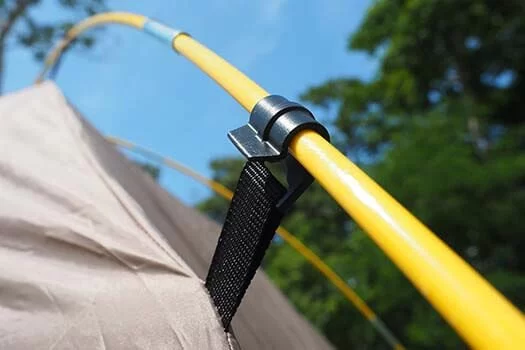- understanding-the-structure-of-tunnel-tents
- why-tent-pole-selection-matters-in-tunnel-tents
- material-considerations-for-tent-poles
- pole-diameter-length-and-flexibility
- real-world-camping-scenarios-and-pole-performance
- common-mistakes-when-choosing-poles-for-tunnel-tents
- get-reliable-tent-poles-from-pine-cliff-resort
1. Understanding the Structure of Tunnel Tents
Tunnel tents are a popular choice for campers who prioritize interior space and efficient pitching. Their design typically includes two or more flexible poles forming semi-circular arches that run parallel, creating a tunnel-shaped structure. But unlike geodesic or dome tents, tunnel tents rely more heavily on tension and correct pole placement for stability.
Because of this, choosing the right tent poles for tunnel tents isn’t just a matter of preference—it’s a performance factor that directly affects the tent’s strength, wind resistance, and even livability.
2. Why Tent Pole Selection Matters in Tunnel Tents
Unlike tents with self-supporting designs, tunnel tents depend almost entirely on their poles for shape and tension. If the poles lack the necessary flex or resilience, the tent may sag, collapse under wind pressure, or strain at the seams. On the other hand, too rigid a pole can make pitching difficult or even risk breaking under stress.
A poorly matched pole may not follow the tunnel curve properly, which could lead to uneven tension, misaligned guy lines, and water pooling on the roof during rain. All of this adds up to one critical truth: your pole choice isn’t secondary—it’s foundational.
3. Material Considerations for Tent Poles
When choosing tent poles for tunnel tents, material is often the first factor campers consider. Here’s a breakdown:
- Aluminum poles: Lightweight yet strong, aluminum is the most common material for mid- to high-end tents. It bends without snapping and returns to shape well under tension—ideal for tunnel curves.
- Fiberglass poles: More affordable but prone to splintering under strain. They’re often found in entry-level tunnel tents, but less suitable for high winds or repeated use.
- Carbon fiber poles: Ultralight and exceptionally strong, but expensive and sometimes brittle under sudden stress. Best for seasoned backpackers prioritizing weight savings.
The balance between weight, durability, and budget plays a huge role here. If you’re unsure what fits your specific needs, Pine Cliff Resort offers side-by-side comparisons tailored to different camping scenarios.
4. Pole Diameter, Length, and Flexibility
Tunnel tents require long, curved poles that maintain structural tension without breaking. So it’s important to match the diameter and flexibility to your specific tent model and size.
Poles that are too thick may resist bending and overstress fabric sleeves, while too-thin poles may bend excessively or fail during a gust. Manufacturers typically provide specs, but if you’re upgrading or replacing poles, you’ll want to make sure they’re:
- Long enough to maintain arch height
- Segmented for packability but smooth in assembly
- Engineered for flex without permanent warping
Custom pole sets are available through gear specialists—and investing in the correct size ensures longevity and stress-free setup.
5. Real-World Camping Scenarios and Pole Performance
During a multi-day trek across the Wind River Range, one group of hikers shared how a tunnel tent with aftermarket aluminum poles outlasted two sudden hailstorms, while a neighboring tent with fiberglass poles cracked after the first night.
In contrast, a family camping near the coast in Big Sur reported that their tunnel tent struggled with aluminum poles that were too rigid—setup became difficult on sloped terrain, and one pole eventually snapped during a hurried takedown.
The takeaway? Choose poles based not only on specs but also based on your specific environment. Coastal winds, alpine cold, or backcountry weight limits all influence which tent pole will serve you best.
6. Common Mistakes When Choosing Poles for Tunnel Tents
If you’ve ever found yourself frustrated while pitching a tent, it might not be the tent’s fault—it could be the poles. Some common mistakes include:
- Using mismatched poles: Even slight length variations can throw off tent geometry.
- Underestimating flexibility needs: Especially for larger tunnel tents where pole arching is more extreme.
- Assuming all replacement poles are equal: Cheap poles often lack the strength-to-weight ratio necessary for demanding conditions.
Avoiding these pitfalls makes your setup smoother and your shelter safer. Consult with experts before upgrading—especially if your tent is discontinued or customized.
7. Get Reliable Tent Poles from Pine Cliff Resort
If you're wondering where to find high-quality tent poles for tunnel tents that actually work in real conditions, look no further than Pine Cliff Resort. Our team tests every pole in the environments you’ll be camping in—whether it's dense forests, rocky plateaus, or breezy hilltops.
We provide expert guidance, detailed specs, and trusted recommendations to ensure your tunnel tent is supported by poles as strong and reliable as the adventures you plan. Because when it comes to shelter, strength starts with the structure.







